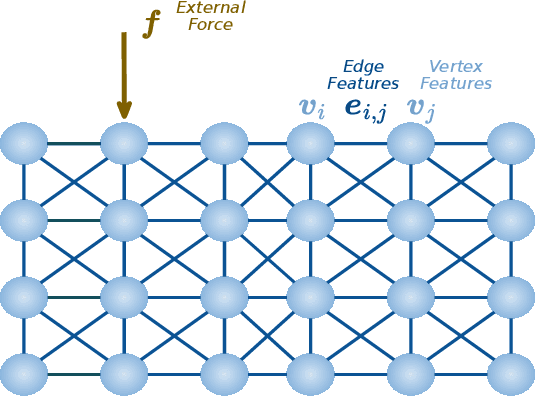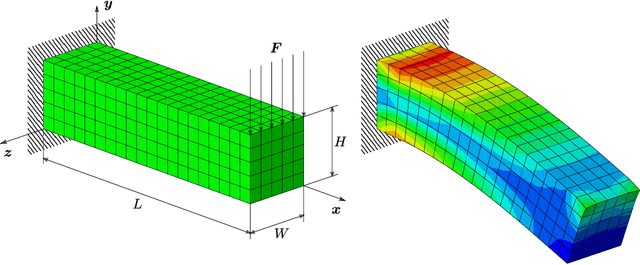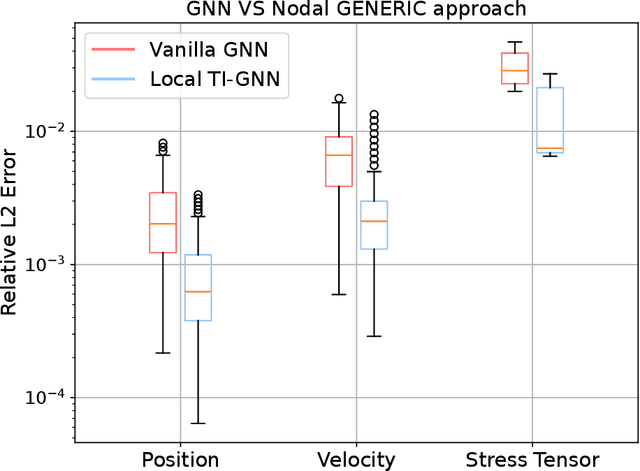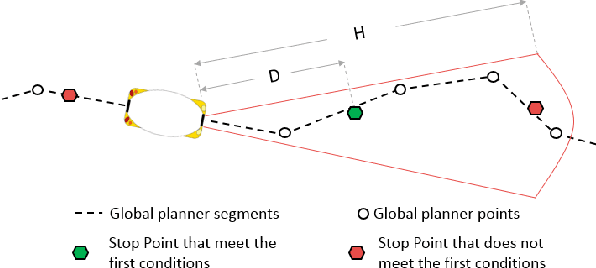David González
Graph neural networks informed locally by thermodynamics
May 21, 2024



Abstract:Thermodynamics-informed neural networks employ inductive biases for the enforcement of the first and second principles of thermodynamics. To construct these biases, a metriplectic evolution of the system is assumed. This provides excellent results, when compared to uninformed, black box networks. While the degree of accuracy can be increased in one or two orders of magnitude, in the case of graph networks, this requires assembling global Poisson and dissipation matrices, which breaks the local structure of such networks. In order to avoid this drawback, a local version of the metriplectic biases has been developed in this work, which avoids the aforementioned matrix assembly, thus preserving the node-by-node structure of the graph networks. We apply this framework for examples in the fields of solid and fluid mechanics. Our approach demonstrates significant computational efficiency and strong generalization capabilities, accurately making inferences on examples significantly different from those encountered during training.
A comparison of Single- and Double-generator formalisms for Thermodynamics-Informed Neural Networks
Apr 01, 2024



Abstract:The development of inductive biases has been shown to be a very effective way to increase the accuracy and robustness of neural networks, particularly when they are used to predict physical phenomena. These biases significantly increase the certainty of predictions, decrease the error made and allow considerably smaller datasets to be used. There are a multitude of methods in the literature to develop these biases. One of the most effective ways, when dealing with physical phenomena, is to introduce physical principles of recognised validity into the network architecture. The problem becomes more complex without knowledge of the physical principles governing the phenomena under study. A very interesting possibility then is to turn to the principles of thermodynamics, which are universally valid, regardless of the level of abstraction of the description sought for the phenomenon under study. To ensure compliance with the principles of thermodynamics, there are formulations that have a long tradition in many branches of science. In the field of rheology, for example, two main types of formalisms are used to ensure compliance with these principles: one-generator and two-generator formalisms. In this paper we study the advantages and disadvantages of each, using classical problems with known solutions and synthetic data.
Description and Technical specification of Cybernetic Transportation Systems: an urban transportation concept
Aug 15, 2020



Abstract:The Cybernetic Transportation Systems (CTS) is an urban mobility concept based on two ideas: the car sharing and the automation of dedicated systems with door-to-door capabilities. In the last decade, many European projects have been developed in this context, where some of the most important are: Cybercars, Cybercars2, CyberMove, CyberC3 and CityMobil. Different companies have developed a first fleet of CTSs in collaboration with research centers around Europe, Asia and America. Considering these previous works, the FP7 project CityMobil2 is on progress since 2012. Its goal is to solve some of the limitations found so far, including the definition of the legal framework for autonomous vehicles on urban environment. This work describes the different improvements, adaptation and instrumentation of the CTS prototypes involved in European cities. Results show tests in our facilities at INRIA-Rocquencourt (France) and the first showcase at Le\'on (Spain)
 Add to Chrome
Add to Chrome Add to Firefox
Add to Firefox Add to Edge
Add to Edge